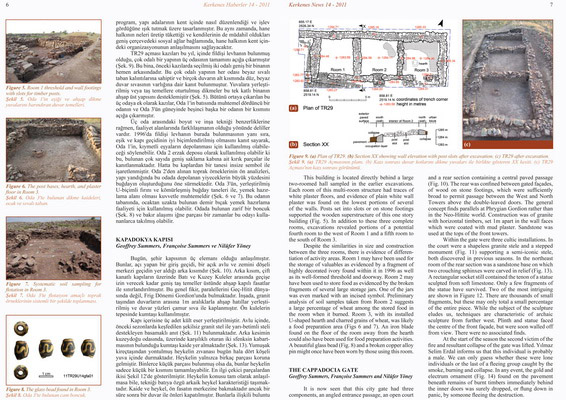| |
This building is located directly behind a large two-roomed hall sampled in the earlier excavations. Each room of this multi-room structure had traces of white plaster fl oors, and evidence of plain white wall plaster was found on the lowest portions of several of the walls. Posts set into slots or on stone footings supported the wooden superstructure of this one story building (Fig. 5). In addition to these three complete rooms, excavations revealed portions of a potential fourth room to the west of Room 1 and a fi fth room to the south of Room 3.
Despite the similarities in size and construction between the three rooms, there is evidence of differentiation of activity areas. Room 1 may have been used for the storage of valuables as evidenced by a fragment of highly decorated ivory found within it in 1996 as well as its well-formed threshold and doorway. Room 2 may have been used to store food as evidenced by the broken fragments of several large storage jars. One of the jars was even marked with an incised symbol. Preliminary analysis of soil samples taken from Room 2 suggests a large percentage of wheat among the stored food in the room when it burned. Room 3, with its installed U-shaped hearth and charred grains of wheat, was likely a food preparation area (Figs 6 and 7). An iron blade found on the fl oor of the room away from the hearth could also have been used for food preparation activities. A beautiful glass bead (Fig. 8) and a broken copper alloy pin might once have been worn by those using this room.
THE CAPPADOCIA GATE
Geoffrey Summers, Françoise Summers and Nilüfer Yöney
It is now seen that this city gate had three components, an angled entrance passage, an open court and a rear section containing a central paved passage (Fig. 10). The rear was confi ned between gated façades, of wood on stone footings, which were suffi ciently broad to permit passage between the West and North Towers above the double-leaved doors. The general concept fi nds parallels at Phrygian Gordion rather than in the Neo-Hittite world. Construction was of granite with horizontal timbers, set 1m apart in the wall faces which were coated with mud plaster. Sandstone was used at the tops of the front towers.
Within the gate were three cultic installations. In
the court were a shapeless granite stele and a stepped
monument (Fig. 11) supporting a semi-iconic stele,
both discovered in previous seasons. In the northeast
room of the rear section was a sandstone base on which
two crouching sphinxes were carved in relief (Fig. 13).
A rectangular socket still contained the tenon of a statue
sculpted from soft limestone. Only a few fragments of
the statue have survived. Two of the most intriguing
are shown in Figure 12. There are thousands of small
fragments, but these may only total a small percentage
of the entire piece. While the subject of the sculpture
eludes us, techniques are characteristic of archaic
sculpture from further west. Plinth and statue faced
the centre of the front façade, but were soon walled off
from view. There were no associated finds.
At the start of the season the second victim of the fi re and resultant collapse of the gate was lifted. Yılmaz Selim Erdal informs us that this individual is probably a male. We can only guess whether these were lone individuals or the last of a fl eeing group caught by the smoke, burning and collapse. In any event, the gold and electrum ornament (Fig. 14) found on the pavement beneath remains of burnt timbers immediately behind the inner doors was surely dropped, or fl ung down in panic, by someone fl eeing the destruction.
|



